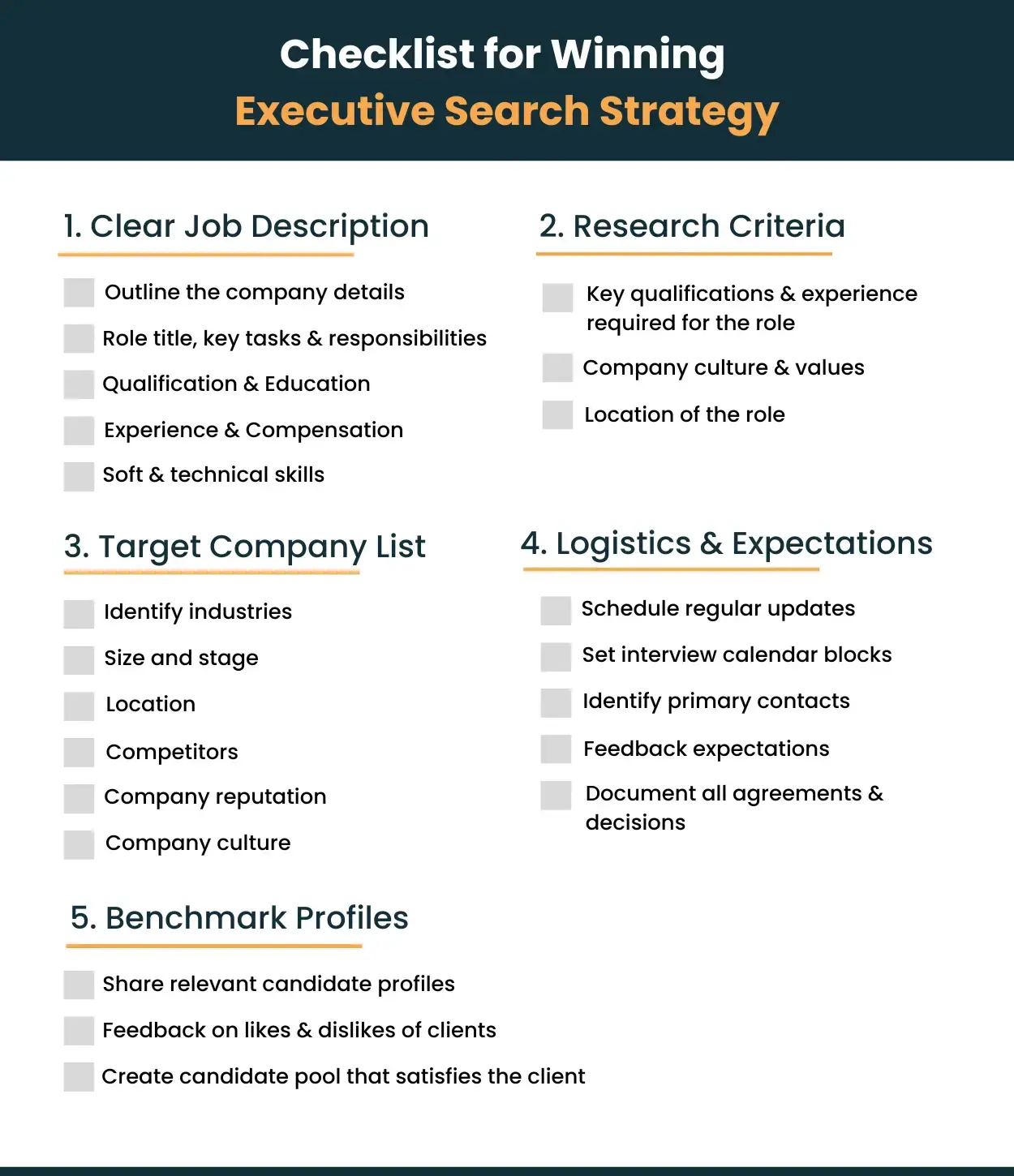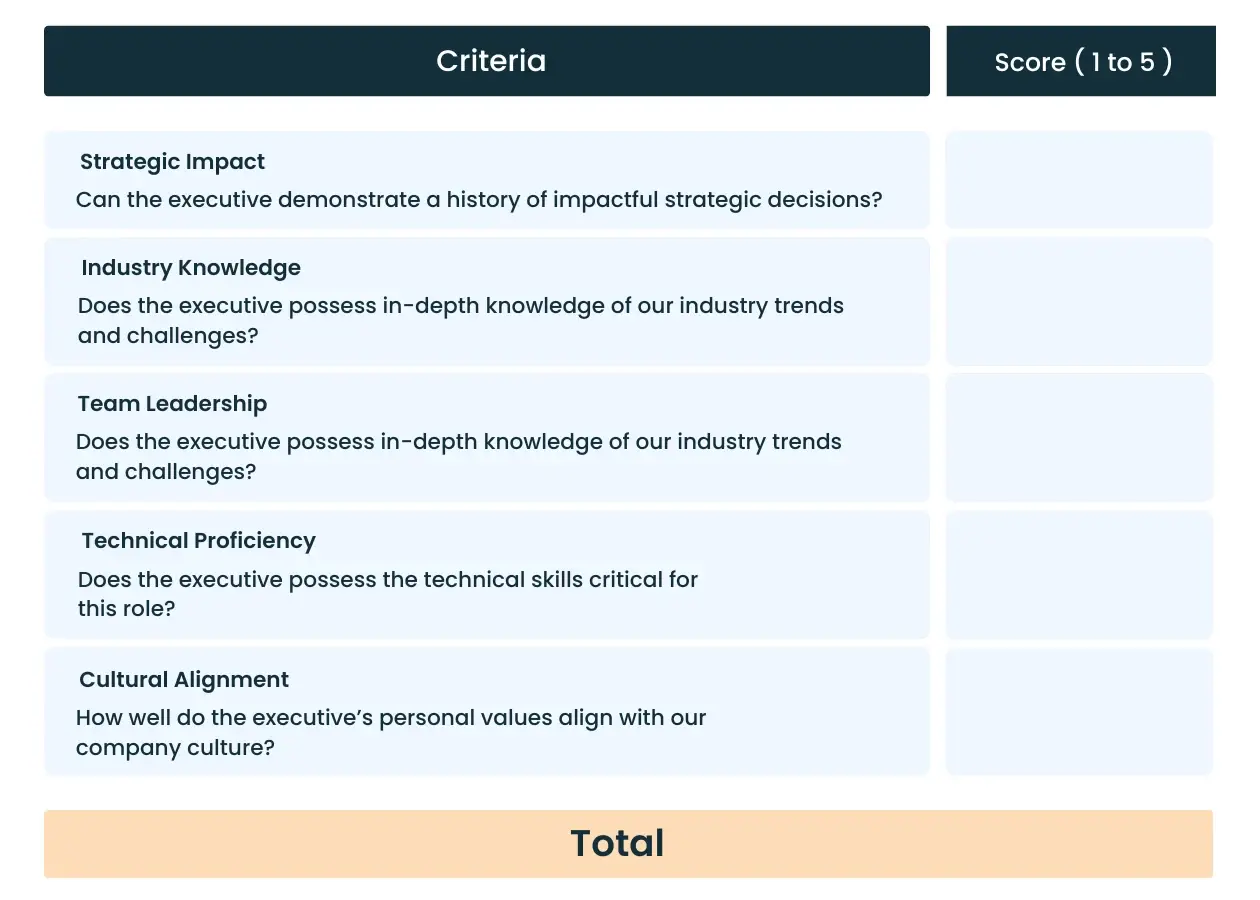TL;DR
- Executive search is a strategic recruitment process targeting passive, top-level executives for C-suite roles.
- The 10-step process includes client consultation, strategy building, research, outreach, assessment, interviews, reference checks, negotiation, onboarding, and post-placement follow-up.
- The process emphasises understanding company culture and role requirements to find the best leadership fit.
- Technology, including AI and executive search software, greatly enhances efficiency in sourcing, screening, and engagement.
Recruiting top executives for CEO, CFO, CTO, and VP positions requires a sophisticated executive search process that goes far beyond traditional hiring methods. With 89% of senior leadership roles filled through executive search rather than job advertisements, understanding this strategic recruitment approach is essential for securing transformational leaders.
This definitive guide reveals the 10-step executive search process used by leading recruitment firms to identify, attract, and hire exceptional C-suite executives. From initial client consultation to post-placement support, you'll discover proven strategies that consistently deliver outstanding results for executive recruitment in today's competitive talent market.
What is the Executive Search Process?
Executive search is a specialised headhunting methodology that identifies and recruits senior executives for C-level positions, including CEO recruitment, CFO hiring, CTO search, and VP-level appointments. This strategic talent acquisition process specifically targets passive candidates, high-performing executives who aren't actively job hunting but may consider exceptional career opportunities.
Unlike traditional recruitment agencies that depend on job ads and active job seekers, executive search consultants take the initiative to identify and reach out to top-tier professionals who are usually thriving in their current roles. This refined approach demands a deep understanding of the industry, a vast network of professional connections, and a significant commitment to research and relationship-building.
According to research by Kestria, 62% of executive search firms report that AI and tech have made the process more effective.
How Do You Start an Executive Search Process?
Executive search processes are similar to regular recruitment processes. But the target candidates are C-level executives.
So, let’s learn these steps of this executive search process and find the best one.
1. Understand Your Client’s Need
A. In-depth consultation with the client
Before you start this process, have a coffee meeting with the client. To understand the client's unique executive recruitment challenges and the specifics of the leadership role they're looking to fill.
Once you have a clear picture, then you can easily tailor your search to their needs and expectations.
B. Analyse company culture & identify talent’s characteristics
In an executive search, executives who fit with company culture and align with your client’s goal are more important.
They are the ones who will lead their teams and company, so having the same goal will boost their company's growth and success. First, you need to understand the company's values, work environment, and leadership expectations to find that executive.
C. Discussing the position's requirements
First, discuss with your clients the exact qualifications, experience, and skills they’re looking for in a candidate. This ensures that only the most suitable executives are considered for the role. Once you know what's needed for the job and understand the company’s goals, it’s also crucial to keep up with the latest industry trends and standards. Finding the perfect executive requires a deep knowledge of the industry and a wide network. The Association of Executive Search and Leadership Consultants (AESC) offers excellent resources to help you expand your knowledge and connect with other industry leaders.
D. Clarifying the timeline and budget for the search
Have an idea of within what time they want talent. Have a clear timeline from your client. Knowing their recruitment budget before is also a crucial part of the process. So you can plan your search accordingly and keep the client informed of progress.
2. Build a Winning Executive Search Strategy
By this point, you know your clients’ needs and are ready to create a winning strategy. Developing a winning search strategy is like building a strong foundation for a house.
It's the blueprint that guides the entire search project. It makes sure that everyone involved is on the same page and working towards the similar goal.
A well-crafted executive recruitment strategy can help you find qualified executives faster and avoid potential roadblocks.
To create a winning search strategy, you'll need to start with a clear job description that outlines the main responsibilities and requirements of the role.
This is like the framework of the house, providing a basic structure around which everything else will be built.
Once you have a solid job description, you can start to provide more details of your search strategy, including the research criteria, target company list, logistics and expectations.
Decide your research criteria, such as having specific qualifications and experience that you're looking for in executives. It will help you narrow down your search to the most promising executives. Also, create a list of target companies.
Focus your efforts and resources on the targeted area. It's the list of companies and industries that you'll target in your executive search process.
Finally, to ensure that your executive search strategy is on track, you'll want to use benchmark profiles to calibrate your search and get feedback from your client.
This is like conducting a final inspection of the house before it's complete, ensuring that everything is up to code and that the client is satisfied with the results.
In layman's language, a benchmark profile means you compare future executives' profiles with your ideal executive. By using benchmark profiles, you can make any necessary adjustments to your search strategy.
3. Conduct the Research
Conducting research for an executive search is like developing the soil before planting seeds in a garden.
It's a crucial step that requires careful planning and implementation to ensure the best possible outcome.
Just as a gardener requires the right tools and a clear understanding of what they're growing, a researcher needs a well-defined recruitment strategy and the right resources to find the best executives.
First, you should start by using what you already have. This means leveraging your existing network and database. Look for people who match the research criteria and are connected to the target companies.
These are your potential executives who are more likely to respond to your outreach because they already have a connection with you.
If this does not work, go for the second step. For that, you should expand your search to include 'sources'.
These are people who may not be an exact fit for the role, but they might know someone who is.
They are like signboard on road who can point you in the right direction, guiding you towards the person who has exactly what you need.
Once you've exhausted your own resources, then it's time to look further afield. This could mean searching online platforms like LinkedIn.
However, these executives are passive executives, and they don't know you, so they might not respond to your outreach. So, it's important to approach them in the right way and to keep track of where each executive came from.
Finally, just as an architect keeps a blueprint of every detail of a building, you should keep clear records of your research.
Use tools like Research Criteria Scorecards to track your progress and showcase your results. This not only helps you stay organised but also demonstrates your competence and thoroughness to your clients or stakeholders.
Now the research is complete is time to do the real work and go out for hunt to find your ideal executive.
4. Start Executive Outreach
Outreach is like the first hello between an executive and a potential job opportunity.
It's not just about sending a mass email to everyone in your database; rather, it's about starting a conversation, building a personal connection, and sending personalised mail.
The best executives for executive roles are usually already employed and not actively looking, so outreach is the key to reaching them and sparking their interest.
So, make sure that your job description is strong enough to spark their interest.
Think of outreach as fishing, where each potential executive is a fish in the sea. Your research is the bait, carefully designed to attract only sharks out of other fishes. So, the success of your outreach will depend on the quality of your research.
You need to understand what factors are important to the executives and what things will attract them. What things are lacking in their current job that you’ll provide them? What are they looking for in a new opportunity?
This will help you tailor your outreach, and you can offer what they are lacking.
The goal of outreach is to connect with executives who not only look good on paper but are also a good fit for the role and the company.
It's not just about selling the opportunity to the executive but also about selling the executive to the client. You need to know more than just where the executive went to school or what their current job is.
Outreach is the initial step in building a relationship with the executive and understanding who they are and what they can bring to the table.
Improving your research strategy is the best way to improve your outreach and increase your chances of success in the executive search process.
5. Executive Assessment and Evaluation
Assessment step of the executive search process that works as a bridge between the research and decision-making process.
This process involves a thorough assessment of the candidate's skills, experiences, and cultural fit, determining whether they truly align with the job requirements and the client's company culture.
This stage requires a deep conversation and a thorough evaluation of the executives, as only a small percentage of them will make it to this point.
In the assessment stage, organisations must delve deep into the executives' abilities and potential red flags.
This involves sharing detailed reports and observations with the client. The goal is to ensure that the client has all the necessary information to make an informed decision.
This includes sharing background information, framing expectations, and communicating any potential red flags.
Think of it as a chef presenting a dish to a food critic, where the chef explains the ingredients, the cooking process, and the inspiration behind the dish.
In the same way, the executive search firm should present the candidate to the client, providing a clear picture of the executive's abilities and how they would fit within the company.
Status reports and Candidate Assessment Reports (CARs) are essential tools in this stage. They allow you to keep the client updated on the progress of the executive search process and to provide a comprehensive write-up of everything uncovered about the finalists.
The CAR is like a report card for the candidate, highlighting their strengths, weaknesses, and the search firm's final recommendations.
It's important to remember that the search firm's role is not to aggressively sell an executive but to present the information and remove any obstacles for a productive conversation so both parties can make the best decision.
6. Shortlist Presentation and Interview Facilitation
After doing all these steps in the executive search process, now it’s time to show off. Present a curated list of top executives to your client.
This should include detailed profiles of each executive, highlighting their strengths, relevant experience, and potential fit within the organisation.
Also, an assessment summary should be provided to give the client a clear understanding of how each executive was evaluated. To do this, you have to arrange an interview with your clients and executives.
Coordinate with both to arrange a suitable time for the interviews. Provide executives with insights into the company culture, interview format, and key stakeholders they will be interacting with.
This will help them prepare and present themselves in the best possible manner.
Handle all the interview logistics, including interview scheduling, travel arrangements (if necessary), and virtual meeting setups require during the executive search process.
Conduct comprehensive interviews with the most promising executives. This could include behavioural questions, situational questions, and competency-based questions to thoroughly assess their skills and suitability for the role.
Provide feedback to the client based on the interviews conducted. If necessary, arrange for second-round interviews with the client's team. After each round of interviews, gather feedback from both the client and the executives.
This will help in making informed decisions and improving the overall process.
7. Reference Checks and Background Verification
Before you start, make sure that the executives have given their consent for the background check and reference verification.
We can't just go in blindly!
Once we get the green light, we can start it.
Reach out to the references given by the applicants. Prepare a set of questions to gather information about the executive's skills, abilities, work ethic, nature, Leadership and management style, resilience, and behaviour with team members.
Some questions could include:
- What was the executive's role and responsibilities?
- How would you describe their performance?
- What are their key strengths and areas for improvement?
- Would you rehire them if given a chance?
- Were they good at leading the team?
After gathering information from past companies, it's time to verify their background, including their educational qualifications, work history, and any other relevant information.
Now, after this, you are piled up with so many lintels, so what you’ll do is compile that into a clear and concise report for every single executive.
So your client can easily able to digest that information.
Share these reports with the client. Discuss the findings with them and answer any questions they might have. This will help them make an informed decision about the executive.
Make sure they are happy with what you have found and find the right treasure for your client's needs!
8. Negotiation & Offer Management
This step of the executive search recruitment process is more about how effectively you can communicate your offer with the executive. By doing this, you can secure top executives.
Before negotiation and offer, the selection comes before the executive search process.
For selection, you have to gather feedback from clients and ensure that you are on the same page. This feedback helps you to understand their preference and concerns, which is very crucial in the end, as they are the ones who will hire.
Once the selection process has been done, The next step is negotiation. For that, you, as the neutral third party, let them have an open room discussion between your client and the executive.
You can attract them by offering alluring compensation. For compensation, you can also directly ask executives what they want. Now, as a third party, your task is to boil down to setting expectations.
Note that many states have laws around what you can and can’t ask an executive, particularly around compensation. Make sure you’re well-versed in the laws that apply in your area.
The main aim behind this negotiation is that it should be a win-win for both parties, and once the executives are onboard, they should not feel dissatisfied.
The next step is to draft an offer, which requires considering many things.
Such as do market research, compensation trends and competitor data to ensure the offered package is competitive.
This might include sign-on bonuses, performance incentives, stock options, or benefits packages tailored to the executive's needs.
Based on this, create an offer later that they can't say no to. Now, it’s time to send them an offer to let them know they got selected.
Congratulations, you conducted an executive search process and got your next top executive.
9. Executive Onboarding
Well, onboarding process support is a crucial part of the executive search process that doesn't end once an executive has been hired.
It's about ensuring that the new executive settles into their role and the organisation smoothly and effectively.
In this step of the executive search process, you provide the new executive with information about the company culture, key personnel, and strategic objectives or facilitate meetings and introductions.
Make sure that the new executive and your client are satisfied with the placement. They must get a positive experience during your executive search process.
The ultimate goal of onboarding support is to ensure the successful integration of the new executive into the organisation.
10. Post-Placement Follow-up
Now that your founded executive has been placed follow up with both parties to check whether everything went well. Are they satisfied?
Another significant step of the executive search process is gathering feedback from both the client and the executive.
It’ll help you to identify areas of strength, what went well, and what did not.
Lastly, it's important to mention the possibility of providing post-placement support to address any initial challenges.
In summary, post-placement follow-up involves maintaining contact with the client and the placed executive, providing necessary support, gathering feedback, and continuously refining strategies for future searches.
It's a vital step in ensuring a successful outcome for all parties involved.
Now, here your work is complete.
Additionally, by conducting an executive recruiting process, you’ll get better day by day and grow your database.
Also, develop and nurture your network over time.
Think of conducting a search like running a race. In order to win, you need to keep up your speed and effort until you cross the finish line.
The same is true for your firm's searches. If you stay focused and committed right up to the end, your firm will be in a stronger position and will achieve more success over time.
What is the Executive Search Process Timeline?
An Executive Search Process Timeline helps keep your senior leadership recruitment efficient and on track. It outlines key milestones and how long each should take, ensuring you find the right executive without rushing or unnecessary delays. This method keeps the search organised and effective, helping you fill crucial positions smoothly and quickly.
Here is the timeline for the whole executive search process so you'll get an idea about the time required to acquire your next bigshot.
So, for this whole executive search process, the total Timeline is approximately 60-74 Days.
This timeline is a general guideline and can vary based on the complexity of the role, market conditions, and client-specific factors.
Strategic Advantages of the Executive Search Process
Let's focus on the strategic advantages specific to the executive search process itself. It enables you to secure top leadership talent effectively.
1. Targeted Search Strategy
This process makes sure that you focus like a sharpshooter on one target (hiring a top executive). The executive who not only has the required skills but also aligns with your culture and goals.
2. Strategic Talent Landscaping
For example, before you start playing chess, you study the board and understand the position of each piece. This will help you to make strategic decisions. This same goes for the executive search process. It provides insight into where the top executive is located, their availability, and how they can be approached, which helps you to make informed hiring decisions.
3. Leadership Qualities Assessment
The executive search process is not the normal recruitment process. It’s not only focused on technical skills; it delves into leadership qualities that are crucial for senior-level roles. It also includes visionary thinking, decision-making capabilities, and the ability to inspire and motivate teams at a strategic level As a result, it only leads you to hire the best leader.
4. Confidentiality and Sensitivity
An Executive search process is conducted like a secret mission. It is designed with enhanced confidentiality. This helps you to keep executives' information private without risking their current jobs.
5. Reduced Competition
In this process, you only approach the passive executives, so they are less likely to be interviewing with multiple companies simultaneously. But for active job seekers, it’s common. This will reduce competition and may lead to a smoother executive search process.
6. Improved Retention
In the executive search process, an executive is currently working in a very good and high position. So, they will only move for the right and best opportunities rather than simply out of necessity. Chances will be higher that they are likely to stay longer at a company, which ultimately improves your retention rate.
7. Risk Mitigation
Hiring for C-level positions comes with significant risks due to the impact these roles have on the organisation. The executive search process is designed to mitigate these risks through a thorough evaluation, background checks, and detailed assessments that assess more than just their resume.
So, to gain these advantages of the executive search process, you have to follow it precisely. By honing in on these key elements of this process, you can strategically position yourself to attract and secure leaders. A leader who will steer your business like a skilled captain, ensuring smooth sailing towards your long-term goals and culture.
What's the Role of Technology in the Executive Search Process?
We just learned the whole executive search process. Now, it is important to understand how recruitment technology can help executive recruiters and headhunting firms manage the executive recruitment process.
So, before implementing executive search software, let's understand the role of technology in the executive search process.
1. Executive Sourcing & Screening Tools
Executive recruiters can leverage AI technology to quickly scan their databases to identify top executives or senior-level talent based on criteria like skills, experience, location, designation, and qualifications.
2. Executive Relationship Management
The Recruiting CRM Systems help executive recruiters maintain high-level engagement. They can track interactions with potential executives, store profiles, and manage smooth communication to ensure a simplified hiring process for top-level executives.
3. Virtual Interviewing and Executive Assessment Tools
By using interview scheduling and management software, you can conduct remote interviews and skills assessments to save time and money. It will help you to manage the interview management workflow.
4. Integration with Networking Tools
Executive search software can connect with networking tools like social media, job boards, mass mailing, VOIP and online meetings to secure smooth data flow across all stages of the executive search process and update strategic planning.
5. Enhanced Engagement with Executives
The software for headhunters provides you with automated and personalised communication tools to keep executives informed and engaged, which will reduce drop-offs and improve the overall experience.
6. Predictive Analytics
This feature predicts future executive search process needs and market trends that allow executive search firms to stay ahead in their strategies.
7. Data Security Features
This ensures the protection of sensitive and client information via robust security measures and compliance with international standards.
8. Advanced Analytics and Reporting
This feature provides insights into key recruitment metrics like time-to-fill and cost-per-hire, helping firms analyse trends and improve their strategies.
9. Executive Database Management
Your executive recruiters can simply segment and manage a complete executive database effectively. Executive headhunters can leverage this database to find the perfect executive using executive search software.
If you want to employ the best executive search software, ensure the software provider offers the features mentioned above.
How Can iSmartRecruit Help You in Executive Search?
Are you looking to hire C-level executives, VPs, or Directors more efficiently for your clients? Then your firm needs a dedicated executive search ATS that simplifies and strengthens the entire recruitment process. This is exactly where iSmartRecruit demonstrates its true value. Designed specifically for executive recruitment, our platform offers the scalability and usability required to meet the unique demands of high-level hiring.
iSmartRecruit uses advanced AI technology to automate time-consuming tasks such as database scanning, candidate identification, and communication tracking. Its intelligent search capabilities help executive recruiters quickly locate suitable leadership candidates within your existing talent pool, reducing time-to-fill for senior roles. In addition, the system supports personalised outreach to build trust and nurture relationships with top executives, ensuring your firm remains top of mind.
So, are you ready to simplify your end-to-end executive search process and hire the best executive for your clients? Then, Book a Demo see how iSmartRecruit helps you manage your workflow.
FAQs - Frequently Asked Questions
1. What is the difference between executive search and traditional recruitment?
Executive search targets passive, high-level candidates (like CEOs and VPs), while traditional recruitment relies on active job seekers and job ads. It’s more strategic, discreet, and relationship-driven.
2. How long does the executive search process take?
Typically 60–74 days, depending on the role's complexity, industry, and client responsiveness.
3. Why is cultural fit important in executive search?
Executives shape company direction. A strong cultural fit ensures better leadership, alignment, and long-term success.
4. How does iSmartRecruit help with executive search?
It automates sourcing, outreach, communication, and assessments using AI — saving time and improving accuracy in executive hiring.
5. How is confidentiality maintained in executive search?
Firms use discreet outreach, secure tools, and strict privacy practices to protect both client and candidate identities.










.webp.dat)





